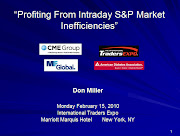So this year, I decided to do two things:
(1) Get myself in the "comeback" mindset in every moment of every trade of every day; and
(2) Not look at my actual equity balance until June 30 and December 31.
For #1, I created the following visualization chart:

What does it reflect? Well, the solid blue line reflects my actual equity curve over a period of time leading up to January 1 -- and this is key -- up to the point of the peak. The subsequent sharp blue retracement line reflects a fictitious and exaggerated significant drawdown, and the dotted rebound reflects how I have traditionally traded after a drawdown.
So effective January 1, I trained myself to believe that I had just experienced a devastating loss and was refocusing for the greatest comeback of all. Then day after day, I mentally put myself at the trough of the "V" bottom just above "support" -- in every moment of every trade of every day. It took some training to turn fiction into firm belief, but I can truly state that I believe this low point is where I will always stand on my equity curve.
As far as #2 and not looking at my balance, it was a pure cold-turkey move as I have always booked my P&L daily and reconciled my brokerage statement balance to my internal records. So effective January, I made it a point to simply view only the portion of my daily statement that contained the trades (to ensure I was flat) and the daily gain/loss and commissions (for booking purposes).
Paraphrasing Dr. Brett Steenbarger, it's difficult -- if not impossible -- for one to trade and keep score. And yes, it was extremely difficult and painful at first, before it eventually became a routine.
I can't begin to overstate what these two actions have done for my trading and fund performance. I looked at total performance and accumulated balance at the end of June for the first time this year, and the results were astonishing. Each of the six months ranked among my best producing months ever, and the true curve is a continuation from the peak above. [But the above chart will be the only one I view, perhaps until I retire.]
Those who know me know that I've always believed and preached that trading is 99% between the ears. The vast array of technical setups provide probability, but that's it. I credit Dr. Steenbarger and his work for triggering much of my thought and action.
I encourage you to find your inner demons & worst weaknesses, fess up to them, and then take action to correct them -- no matter how crazy it seems. In trading and in life.
















3 comments:
Now that you have had a good run, have you thought of changing your mind-set from "bounce-back" to "boring consistency", i.e. a strategy on avoiding the big drawdowns? That requires accepting small losses (before they mushroom) with the confidence that they are just the 'working capital' of a successful business.
Hi andrea.
For me personally, I tend to lose focus when I'm not in that energized state that typically follows an actual draw. I suppose it's just how I'm wired, maybe like a closing relief pitcher. The minute I begin to think that something is somewhat routine, it's usually the start of trouble.
One question of course is can such a mindset be sustained over a long period of time, and thus far the answer for the most part has been it can be sustained enough times to help. Obviously that state of mind can't be "on" 100% of the time, lest we be robots.
Having said that, I'm subconsciously very aware that actual draws will occur as a matter of course ... and am simply trying to minimize their frequency or extent resulting from the wrong reasons.
Once I reach December 31, I'm going to take a hard look at the results and approach to reevaluate things, but that's a while away still.
Don
Don, I have just finished the classic, "Psycho-Cybernetics", by Maxwell Maltz, and the technique you describe, is one he talked about in the 60's. It's recommended reading, as is "The Secrets To: Emotion Free Trading ", by Larry Levin. As it's shorter, read it first.
Cheers,
Post a Comment